
Interior, First Floor, Staircase and Gallery, Welfare Island, Insane Asylum, New York, New York County, courtesy Library of Congress
The Canton Asylum for Insane Indians was inspected many times throughout its life. However, inspectors tended to focus on “things” rather than people. In a January, 1912 report that discussed some sewer problems at the asylum (see last post), Inspector Jacob Breid also discussed–in detail–the physical condition of the building.
“The floors are hard maple but they have not been oiled. They have been scrubbed frequently and the dirty water has gotten into the spaces between the boards and caused the edges to become dark. This gives the floor a dirty appearance . . . .” Breid suggested that the spaces between the boards be filled with a material like wax and the floors oiled. (He also suggested that these floors be mopped with a “cloth moistened with kerosene” rather than with soap and water.)
In the wards, Breid noted that the beds didn’t have castors and therefore scratched and marred the floors whenever they were moved. He suggested using pegs with rounded ends in each bed post and oiling them so that they would glide across the floor. Most of Breid’s comments and suggestions concerned the physical state of the asylum.
So far as patients were concerned, Breid made a list of how many patients held various diagnoses. He also noted that several patients had tuberculosis and needed to be isolated to a greater degree than the building allowed. Breid completed his review of patients with the hopeful thought that the asylum’s new hospital would be erected soon and alleviate this problem of isolating contagious patients.







